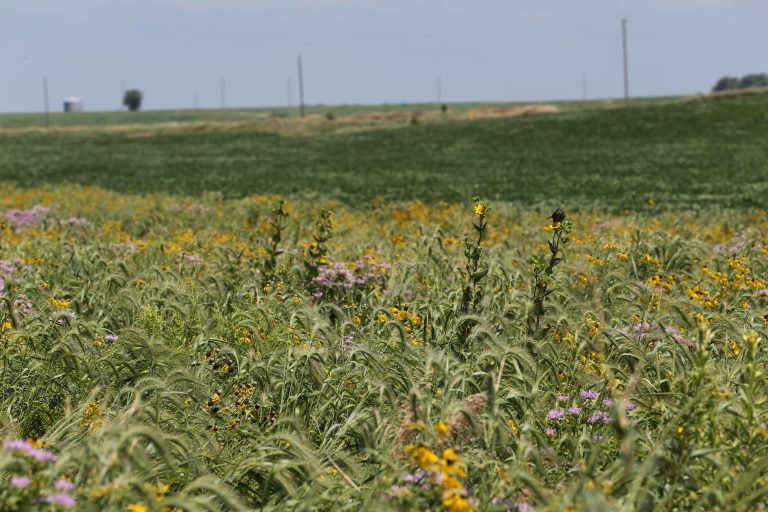Farmers and landowners enrolling acres in the U.S Department of Agriculture’s Conservation Reserve Program have a new practice available to them.
Areas of native grasses and flowers, called prairie strips, have proven helpful in keeping soil in place, preventing nutrients from washing away and increasing the presence of birds and bees.
Researchers from Iowa State University began their study of prairie strips more than 15 years ago and over time invited farmers and land owners to give them a try. Growing interest from farmers alongside peer-reviewed research showing several environmental benefits of prairie strips attracted attention from USDA.
“While we had good results, research, already from our initial experiments, they particularly were interested in the research we were doing on commercial farms,” said Lisa Schulte Moore, an Iowa State University professor and member of the prairie strips research team.
That led to five years of funding from the Farm Service Agency, the USDA branch that manages sign up and practice selection for the Conservation Reserve Program, to expand their experiments to more commercial farm fields. The promising results prompted USDA staff to work with Congress to have prairie strips included in the 2018 farm bill. That established them as another option people can choose from when putting acres into conservation. It took a bit over a year to work out the details.
“They can get a cost-share for the establishment of that practice and then a rental payment for 10 years… on those acres that are taken out of production,” said Bill Northey, USDA undersecretary for farm production and conservation. Northey said USDA often makes tweaks to the conservation practices it includes in its programs, but it’s less common to add something completely new. The last time that happened was in 2017 with bioreactors and filter strips, also intended to improve water quality.
Schulte Moore says each person inquiring about prairie strips is going to have a specific resource issue to address—such as nutrient runoff or soil loss. Identifying the goal of the installation is really important, she says, because the implementation needs to be customized.
“When you look at integrating prairie strips, you do really need to start with that field level and understand the spatial arrangement of all the elements and the operations that are going on in the field,” Schulte Moore said. “It really is a field by field by field decision.”
The presence of terraces, existing grass waterways and conservation measures already in place at the edge of a field all will influence how the prairie strips are designed. Another agency, often located in the same building as the county FSA office, the Natural Resources Conservation Service, will work with the farmer or landowner to design and engineer the prairie strips
Schulte Moore says there’s been a lot of interest in prairie strips beyond the handful of early adopters who’ve tried them.
“We’ve been hearing from a lot of farmers and farmland owners saying, ‘I really want to do prairie strips, but I just can’t make it pencil out financially.’”
Sometimes they’ve asked about federal program support and now the CRP option may make prairie strips feasible for them.
Northey sees widespread opportunity for the use of prairie strips.
“You would need to have a water quality benefit that folks are looking for, but it also offers a wildlife benefit too,” he said. “And so those areas that will have farming that is happening intensely, where you could have loss of nutrients that could be benefitted by having those prairie strips, actually would include a lot of the country.”
As Iowa secretary of agriculture, Northey oversaw the implementation of the Iowa Nutrient Reduction Strategy, an entirely voluntary set of suggestions intended to improve water quality by enlisting farmers to reduce chemical and soil run off from their fields.
Follow Amy on Twitter: @AgAmyinAmes
9(MDM5MjE5NTg1MDE1Mjk1MTM5NjlkMzI1ZQ000))

